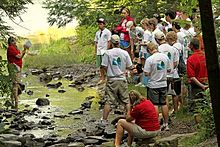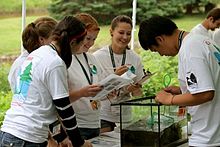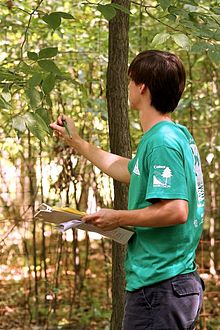 Logo Logo | |
| Purpose | Environmental competition |
|---|---|
| Headquarters | Washington, D.C. |
| Website | envirothon |
| Formerly called | Environmental Olympics, Enviro-Olympics |
NCF-Envirothon is an annual environmentally themed academic competition for high school aged students organized by the NCF-Envirothon a program of the National Conservation Foundation. The competition is held by the United States and Canada on a regional, state, and bi-national level. In select years, the competition has also included China and Singapore. Envirothon combines in-class and hands-on environmental education in a competition setting which involves a problem-solving presentation as well as written field tests. The competition tests students on five core subjects — aquatic ecology, forestry, soils and land use, and wildlife — along with a fifth annually-changing subtopic which focuses on relevant environmental issues. Currently, roughly 500,000 students from forty-five U.S. states and nine Canadian provinces/territories participate in the competition.
States and provinces across the United States and Canada each have their own local competitions from which the winning high school team earns the privilege of representing their state/province at the NCF-Envirothon competition, held each summer in a different U.S. state or Canadian province. In areas with a considerable number of teams, subdivisions such as county, regional, or district competitions are also held. Teams must win these intermediary competitions in order to move on to the state/province levels.
Organizers and Sponsors
The NCF-Envirothon is a 501(c)3 Nonprofit organization headquartered in Washington, D.C. The organization also relies heavily on volunteers across North America to advise individual teams from each participating state and province. Governing the program is the National Conservation Foundation (NCF) Executive, along with a NCF-Envirothon Operating Committee which is made up of representatives from participating states and provinces.
Envirothon is sponsored by the National Conservation Foundation, the National Association of Conservation Districts, the United States Forest Service, and the Natural Resources Conservation Service. Individual teams are often sponsored by school clubs or classes, local businesses and governments, or 4H and other such non-scholastic organizations.
Competition
Competition participants are generally teams of five students with one to two team advisers. Home-schoolers can also take part as their own team.

States and provinces across the United States and Canada each have their own local competitions from which the winning high school team earns the privilege of representing their state/province at the North American Envirothon Competition, held each summer in a different U.S. state or Canadian province. In regions with a considerable number of teams, competitions on subdivision, county, regional, or district levels are also held. Teams must win these intermediary competitions in order to move on to the state/province levels. At the North American Competition, teams that rank first through tenth receive prizes and scholarships of various values.
Competition week at the NCF-Envirothon level includes various workshops, field trips, and seminars led by professionals and educators for both the students and their advisors. Most of these outings are linked to the current issue topic and provide information on the area in which the competition is being held.
During the competition, each team must complete five written field tests, each dealing with a different topic. These tests consist of various question types, including identifications and hands-on assessments. Each team must also prepare an oral presentation on the current issue topic, which the team presents to a panel of judges. An important element of the competition is the understanding that each topic is interrelated, and understanding human effects on the environment and how human activities connect with ecosystem functions. Each test is scored out of 100 points, with the presentation being scored out of 200 points. The team with the highest cumulative total of points at the end of the scoring is the winning team. Recognition is also given to teams with the highest scoring in each of the five categories.
Competition locations
The location of the North American competition is determined based on a regional map that separates North America into five general regions: Far West, Mid-West, Southeast, Northeast, and Far North. The host college or university is usually located in a different region than that of the year preceding it. For example, a competition (2013) was held in at Montana State University in Bozeman, Montana in the Far West.
Competition Topics
| This section needs additional citations for verification. Please help improve this article by adding citations to reliable sources in this section. Unsourced material may be challenged and removed. Find sources: "Envirothon" – news · newspapers · books · scholar · JSTOR (January 2015) (Learn how and when to remove this message) |
Each field test dealing with one of five competition topics requires both theoretical understandings and hand-on skills such as identification and chemical testing. Each topic also has a degree of relatedness to one another, which is sometimes considered in theoretical-based test questions.
Aquatic Ecology
Source:

- Learning objectives includes the hydrosphere, aquatic ecosystem, aquatic organisms, water protection and conservation, and the connection of water to society, and more.
- The field test deals with these learning objectives, with focuses on the functions and significance of watersheds and wetlands; the identification of aquatic organisms and their connections between water quality; and water use, regulation, and threats such as invasive species.
- Hands-on tasks conducted during the field test include identification of wetland types and species, outlining a watershed on a topographic map, and performing chemical water quality tests.
Forestry
Source:

- Learning objectives include tree and shrub physiology, forest ecology, sustainable forest management, and trees as important renewable resources, and more.
- The field test also focuses on forest structure in relation to biotic and abiotic factors; silviculture techniques and tool use; and the identification and management of invasive species and diseases.
- The test's hands-on portion includes various tasks such as identifying trees, using common forestry tools, collecting tree core samples using an increment borer to determine tree age and historical influences, and tree planting using proper techniques.
Soils and Land Use

- Learning objectives include physical properties of soil and soil formation, soil ecosystems, chemical properties of soil, soil conservation and land use management, and soil surveying, among others.
- Within these objectives lie focuses on identifying and understanding soil profiles and horizons; chemical properties and balances of soil; and understanding soil data, surveys, and drainage and their relations to soil use.
- The field test includes hands-on tasks such as soil texture, type, color, identification, outlining the different horizons in a soil profile, and performing chemical soil property tests.
Wildlife
- Learning objectives for the Wildlife field test include knowledge of wild birds and mammals, wildlife ecology, conservation and management of wildlife, and issues involving wildlife and society, among other objectives.
- Other topic focuses include understanding food habits and skull morphology of wildlife species; habitat features and influences; wildlife adaptations; and predator/prey relationships and carrying capacity of ecosystems; and how humans, introduced species, and diseases affect wildlife.
- Hands-on tasks conducted during this test include using an identification key to identify wildlife pelts, skulls, footprints, and calls/sounds; and using Global Positioning System to track tagged specimens.
Current Issue
- The fifth topic changes annually, and deals with issues affecting present-day society and environment.
- The Current Issue field test focuses on theoretical understandings of the issue in relation to the other four competition topics, as well as some hands-on activities. Current Issue Topics have included, Urban Forestry (2015), Sustainable Agriculture and Locally Grown (2014), Sustainable Rangeland Management (2013), Nonpoint source pollution/Low Impact Development (2012), Salt and Freshwater Estuaries (2011), Protection of Groundwater Through Urban, Agricultural, and Environmental planning (2010) and Biodiversity in a Changing World (2009), among others in earlier years.
History
In 1979 the Pennsylvania Soil and Water Conservation Districts set up the Environmental Olympics, later renamed Enviro-Olympics, to encourage interest in environmental issues through hands-on competition. Expanding rapidly to include forty conservation districts by 1987, it gained attention from other states, and in 1988, the program became the National Envirothon, with participation from Pennsylvania, Massachusetts, and Ohio. In 1992 Nova Scotia became the first Canadian province to join the competition. The competition was sponsored by various state, local, and provincial conservation programs and associations until 1997 when Canon Inc. began its support of the program, with local sponsors still supporting lower level competitions. In 1999 Canon became the title sponsor of the competition between the U.S. states and Canadian provinces, with the competition being renamed the "Canon Envirothon." It is currently referred to as the "NCF-Envirothon."
Results
Hosts and top-five competition place winners from past North American Envirothon competitions:
| Year | Host | 1st Place | 2nd Place | 3rd Place | 4th Place | 5th Place |
|---|---|---|---|---|---|---|
| 2023 | Mount Allison University | Massachusetts | Pennsylvania | Ontario | Florida | New Mexico |
| 2022 | Miami University, Oxford, Ohio | Massachusetts | Maryland | Florida | New York | North Carolina |
| 2021 | Nebraska Association of Resources Districts | New York | North Carolina | South Carolina | Massachusetts | Florida |
| 2019 | North Carolina State University, Raleigh, North Carolina | Virginia | North Carolina | Pennsylvania | New York | Mississippi |
| 2018 | Idaho State University, Pocatello, Idaho | New York | Montana | Virginia | New Mexico | South Carolina |
| 2017 | Mount Saint Mary's University, Emmitsburg, Maryland | Pennsylvania | New York | New Mexico | Missouri | Ohio |
| 2016 | Trent University, Peterborough, Ontario | Ontario | Pennsylvania | California | Missouri | Maryland |
| 2015 | Missouri State University, Springfield, Missouri | Missouri | Pennsylvania | Texas | Massachusetts | New York |
| 2013 | Montana State University, Bozeman, Montana | New York | Massachusetts | Missouri | New Hampshire | Mississippi |
| 2012 | Susquehanna University, Selinsgrove, Pennsylvania | Missouri | Ontario | North Carolina | Ohio | New York |
| 2011 | Mount Allison University, Sackville, New Brunswick | Manitoba | Ontario | South Carolina | New Brunswick | Connecticut |
| 2010 | California State University, Fresno, California | California | Delaware | Minnesota | Florida | Maryland |
| 2009 | University of North Carolina, Asheville, North Carolina | Pennsylvania | North Carolina | Maryland | Delaware | Missouri |
| 2008 | Northern Arizona University, Flagstaff, Arizona | Delaware | Missouri | Pennsylvania | New York | Ohio |
| 2007 | Hobart and William Smith Colleges, Geneva, New York | Connecticut | Pennsylvania | Delaware | Missouri | New Jersey |
| 2006 | University of Manitoba, Winnipeg, Manitoba | Virginia | Pennsylvania | Texas | California | Ohio |
| 2005 | Southwest Missouri State University, Springfield, Missouri | Pennsylvania | Virginia | Delaware | Kentucky | North Carolina |
| 2004 | West Virginia Wesleyan College, Buckhannon, West Virginia | Florida | Virginia | New Jersey | Kentucky | North Carolina |
| 2003 | Mount St. Mary's University, Emmitsburg, Maryland | Pennsylvania | New Hampshire | North Carolina | Manitoba | Maryland |
| 2002 | Hampshire College, Amherst, Massachusetts | New Hampshire | North Carolina | Pennsylvania | Vermont | Ohio |
| 2001 | Hinds Community College, Raymond, Mississippi | Pennsylvania | Mississippi | North Carolina | New Jersey | New Hampshire |
References
- "Envirothon: About Us". Retrieved 31 December 2014.
- "Canadian Forestry Association New Brunswick". CFANB. Archived from the original on 15 September 2014. Retrieved 20 November 2012.
- ^ NCF-Envirothon Official Webpage, 2008
- "North American Envirothon: About Us". North American Envirothon. Retrieved 29 October 2012.
- ^ April Smith (2 November 2010). "History Of Envirothon" (PDF). North American Envirothon. Retrieved 8 November 2012.
- "North American Envirothon: Sponsors". North American Envirothon. Retrieved 29 October 2012.
- "Canadian Forestry Association". CFA. Archived from the original on January 20, 2013. Retrieved 20 November 2012.
- "Envirothon: Future Competitions". North American Envirothon. Retrieved 20 November 2012.
- MSU picked as site for 2014 NCF-Envirothon competition, Bozeman Daily Chronicle, October 9, 2012, retrieved 20 November 2012
- "Curriculum Guidelines – NCF-Envirothon". Retrieved 2020-01-04.
- "Aquatic Ecology – NCF-Envirothon". Retrieved 2023-05-05.
- "Forestry – NCF-Envirothon". Retrieved 2023-05-05.
- "North American Envirothon Curriculum Guidelines". North America Envirothon. Retrieved 8 November 2012.
- "Envirothon: Current Competition". North American Envirothon. Retrieved 8 November 2012.
- "Envirothon: Past Competitions". North American Envirothon. Retrieved 8 November 2012.
- "2023 NCF-Envirothon New Brunswick – NCF-Envirothon". Retrieved 2023-12-31.
- "2022 NCF-Envirothon Ohio Competition – NCF-Envirothon". Retrieved 2023-04-27.
- "2021 NCF-Envirothon Nebraska – NCF-Envirothon". Retrieved 2023-04-27.
- "2019 NCF-Envirothon North Carolina – NCF-Envirothon". Retrieved 2023-05-05.
- "New York High School Named 2018 NCF-Envirothon Champions". NACD. Retrieved 2019-07-25.